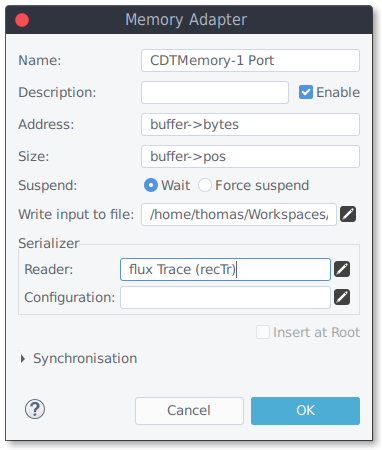RE01 CDT Memory Adapter
Outline
The CDT Memory Adapter reads memory data blocks from the CDT debugger. The start address/size can be defined explicitly or in form of debug expressions (e.g. trace->buffer). The received data is forwarded to a configurable reader. The adapter can be combined with other adapters using a multi-adapter port.
| Platforms: |
|
|||
| Requirements: |
|
|||
| Known limitations: |
|
|||
| Status: |
|
|||
| Operations: |
|
|||
| Parameters: |
|
Video
Source Configuration
Fixed Address
- Address: Address of the memory block in the target process (e.g. 0x40000).
- Size: Size of the memory block in bytes (e.g. 0x200).
Variable Address
- Address expression : Address expression of the memory block in the target process (e.g. trace->buffer).
- Size expression: Size expression of the memory block in bytes (e.g. trace->length).
You may specify a file "Write input to file" to store the raw input for debugging purpose.
Serializer
Configure the serializer by selecting a reader and optionally a reader configuration (some reader require a configuration, e.g. the CSV reader).You may use the buttons '+' and '...' to add and manage existing reader configurations (Preferences).
You may use the "Test Line Reader" (extracts lines from the raw input) and "Test Block Reader" (extract fixed size byte blocks) for debugging purpose.
 32/64bit
32/64bit 32/64bit
32/64bit 32/64bit
32/64bit

